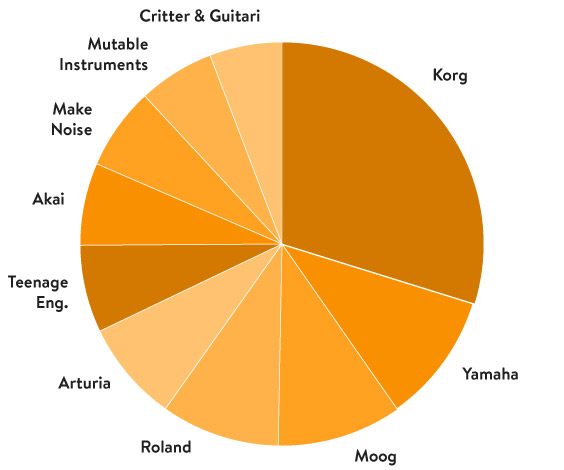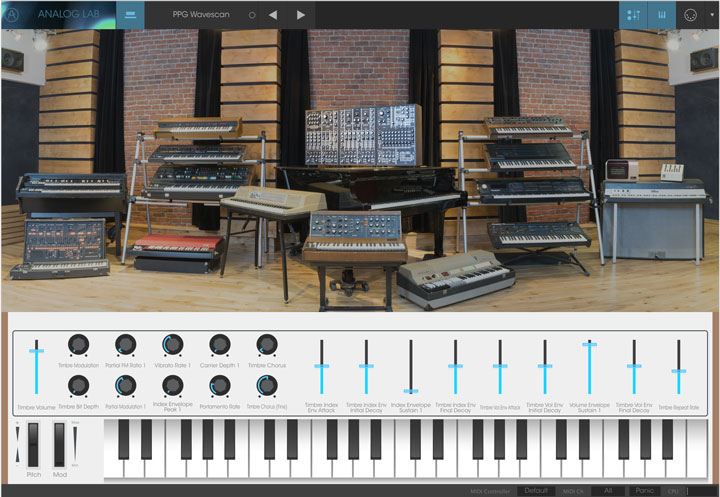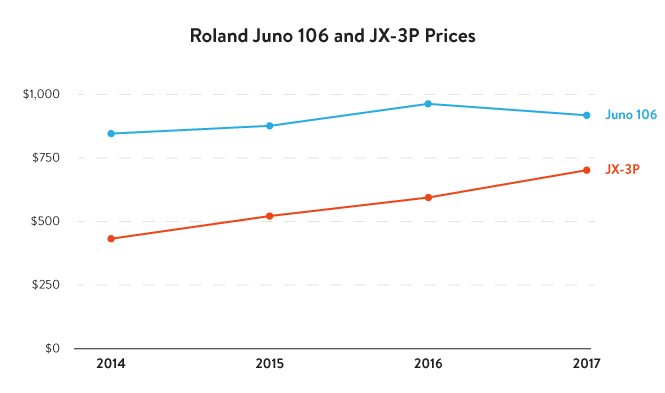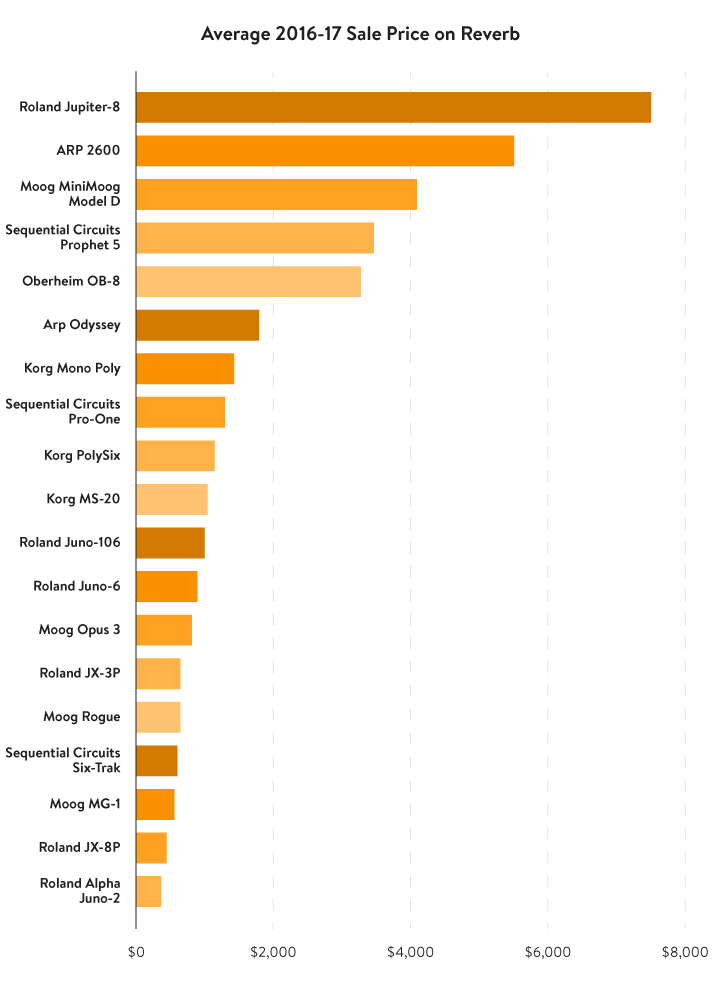Prices on vintage analog synthesizers are very high — higher than they've ever been, in fact. Oscillators and MIDI sequences dominate pop radio, and today's legion of tastemaking producers armed with Junos and Minimoogs is larger than ever.
But these high tides are nothing new.
Analog synths have steadily been getting more expensive for years now, following a period of dormancy during the digital boom between the late '80s and early 2000s. If you comb through archives of any gear forum, you'll see pages of threads dating back a decade full of would–be buyers lamenting high vintage synth prices. People were surprised when bluechip Junos crossed $800. Today, the best specimens can clear $1,400.
Prices are at such a crest that many have begun to wonder if we're approaching the end of peak synth pricing. Such prognostications have been around for as long as the high prices themselves, but today's market is unprecedented in many ways.
While the demand end of the analog synth equation shows no sign of cooling off, the supply side has started to grow with new, mass–produced analog synths hitting the market for the first time since the 1980s.
Will these forces lead to a downturn for vintage prices? Let's take a closer look.
The New Wave of Analog Synth Production
Just 15 years ago, if you were interested in working with the sounds of an authentic analog oscillator your options were limited to vintage and a small high–end boutique scene. Today, more and more major music gear makers are climbing aboard the analog train which, combined with simple economies of scale, means lower prices on new synths across the board.
Chad Allen operates Switched On Music Electronics in Austin, one of the finest synth shops in the world. As he explained:
"It seems like prices for the most common classic synths that were manufactured in large numbers have been dampened by real quality new analog instruments. Finally, we musicians have access to new, inexpensive, reliable, and flexible analog synths that actually sound good, thereby rendering a lot of vintage gear obsolete. "
Synth Marketshare on Reverb
By Number of Orders

Vintage Synth and Keyboard Sales

Brand New Synth and Keyboard Sales
Of the big three keyboard brands, Korg understands this market better than anyone. Synths like their reissue of the MS–20 and Arp Odyssey offer the sounds of vintage in an affordable, readily available package.
"With new reissues out, vintage Korg MS–20s and Arp Odysseys can be found at prices not seen since about 10 years ago," explained Allen.
Beyond these reissues, the polyphonic Korg Minilogue was the most popular new keyboard on Reverb last year, with similarly targeted instruments coming from Arturia and Novation among others. Even low–end audio giant Behringer has entered the market recently with the Deepmind, and have hinted at a whole range of cheap synth clones coming soon.
Roland's spin on this approach comes in the form of their Boutique Series, which replicates some of their classic models at a fraction of the price. While these diminutive devices are digital and certainly no stand–in for a real Jupiter or Juno, they still offer a direct alternative for players seeking that particular set of sounds.
In a higher price bracket, Dave Smith Instruments and Moog Music — both modern chapters of two classic synth lineages that launched in 2002 — are offering more alternatives to vintage originals. Moog released a direct reissue of the all–time classic Minimoog Model D last year, while DSI's line of modern Prophets and other analog models grows every couple of NAMMs.
"Prices on a lot of the '70s Moogs have stalled. The new Model D killed the vintage market for Minimoogs," Allen explained. "Sequential Prophet 5s haven't increased much in price, if at all. Though it sounds completely different, a lot of musicians are choosing the Prophet 6 for its reliability."
Karl Myers is one of the co–founders of vintage gear mega store Main Drag Music in Brooklyn and shares a similar perspective. "After several strong years of growth in this area, we are definitely seeing a leveling off. Part is saturation, but I also think a lot of it is the increase in great new analog synths that have hit the market in the last few years. Between new Dave Smith, Korg, and Moog releases, current production units are taking a chunk of vintage market share."
All of this means that today's synthesists at every experience level and price bracket have a robust array of modern hardware options to consider when seeking out analog tones.
To be sure, for many players, no modern recreation will ever surpass the appeal of an original. For others, though, the convenience and reliability of these modern instruments can be enough to counteract the mojo factor.
Vintage synths are, after all, only getting older, and for gear that's already known for its fragility and high maintenance requirements, sometimes the headache just isn't worth it.
Eurorack and Plugins
Similar competition for today's synth dollars also comes from the always innovative and ever–expanding modular scene, as well as the power of modern computing.
In the case of modular, the Eurorack market is undeniably one of the most innovative subsections of the music gear world and is rapidly racking up more and more devotees with each new offering. Eurorack systems allow musicians to create instruments and sounds hitherto only heard in various fever dreams and acid trips.
While a bit costly to get into, Eurorack and other format systems are, by their modular nature, easy to maintain and capable of achieving virtually any sound.
Virtual instruments — aka Softsynths — also bring an enormous range of vintage and new sounds to modern producers. VSTi plugins are far from a new invention, but unlike a decade ago, today even a relatively humble laptop can run a VSTi–loaded DAW like Ableton Live.
While we lack the space (and will power) here to get into the debate on the perceivable sonic differences between something like the the Arturia V Collection and the vintage synths it emulates, these do offer yet another mechanism with which to obtain the sounds of analog synths without the cash needed for a hardware collection.
It's important to note that none of these options — from modern Korgs to Euroracks and VSTis — are direct substitutions for a classic vintage synth. The appeal of an original Juno or Prophet is as much about the history, feel, and specific combination of original parts as it is about any set of sounds.
At the same time, it's clear that there are more chafing dishes at the synth buffet, all of which chip away at the vintage monopoly over the analog experience.

Arturia Analog Lab
Signs from the Lower End of the Market
One phenomenon you see in all of the various pockets of the used gear market follows this basic pattern: price increases on core, classic models exceed the budgets of most musicians. As an alternative, these players seek out similar sounds from less celebrated, secondary models.
In the case of the guitar market peak of the mid–2000s, when prices on '50s Les Paul Standards and Customs were out of the range of most players, prices started to creep up on Les Paul Juniors, and previously discounted '70s models like the Les Paul Deluxe.
A similar dynamic can be seen with pre–CBS Stratocasters vs '70s models, or in major price increases with budget brands like Teisco and Harmony.
In the used synth world, while prices on the dwindling supply of true classic models still in circulation will probably stay high, inflated prices on lower end models like the Moog Prodigy and menu–driven analog synths of the mid–'80s will likely correct as their station as the only affordable alternative to core vintage analog models erodes.
Myers of Main Drag sees it like this:
"I think really clean, classic models like 2600s, Model Ds, CS–80s, Jupiters and Prophets will continue to increase in value but at a much slower pace, whereas all the secondary models in less–than–perfect condition will at least stabilize, if not slip back. We saw the exact same thing in the vintage guitar market in the mid–2000s."
For a recent example of this phenomenon, we can look to the always vibrant '80s Roland market and the Juno series in particular:

While pricing on the mainstay Juno–106 have remained relatively flat, increasing just under $100 on average over four years, the less–coveted JX-3P has climbed from around $475 to over $700 over the same period. The JX–3P rightly does have its share of fans, but its lack of knobs and sliders in favor of a menu–driven interface make it the less desirable of the two for most players.
While not every increase is as pronounced as the JX–3P, there are plenty of other examples of second tier synths rising in price in recent years. The Moog MG–1 Concertmate — a basic synth built for Radioshack — is now regularly trading for over $600, for example.

The Future of the Synth Market
The downturn of the guitar market nine years ago was probably inevitable to some degree, but it took the global economic recession to trigger the fall. It's important to remember that with any hypothetical synth bubble, overall pricing shifts are more directly impacted by broader economic factors than the short–term trends in musicians' tastes.
There's also a very human element to vintage gear sales that contribute to overall price stability. When someone buys a vintage synth and adds a few hundred dollars in parts and repairs, they are unlikely to list it for less than their purchase price.
Similarly, with an ever–growing global marketplace fueled by sites like Reverb, the potential buying pool is larger than ever, making it more likely that you'll be able to find a willing buyer at higher prices. To the chagrin of many, the age of internet sales has also decimated potential for those mythical pawn shop and garage sale finds, though that's been the case for years.
Ultimately, like any other market, synth prices are impossible to predict. While some stabilization or correction on the lower tier does seem likely, any change will most certainly be very gradual with plenty of outliers and random flair ups along the way.
But regardless of where vintage prices go, one thing is very clear: it's a good time to be a synth lover.
Have a unique perspective or opinion on these issues? We'd love to hear about it. Send your "Letters to the Editor" to [email protected].
Vintage Synthesizers